Recent Articles
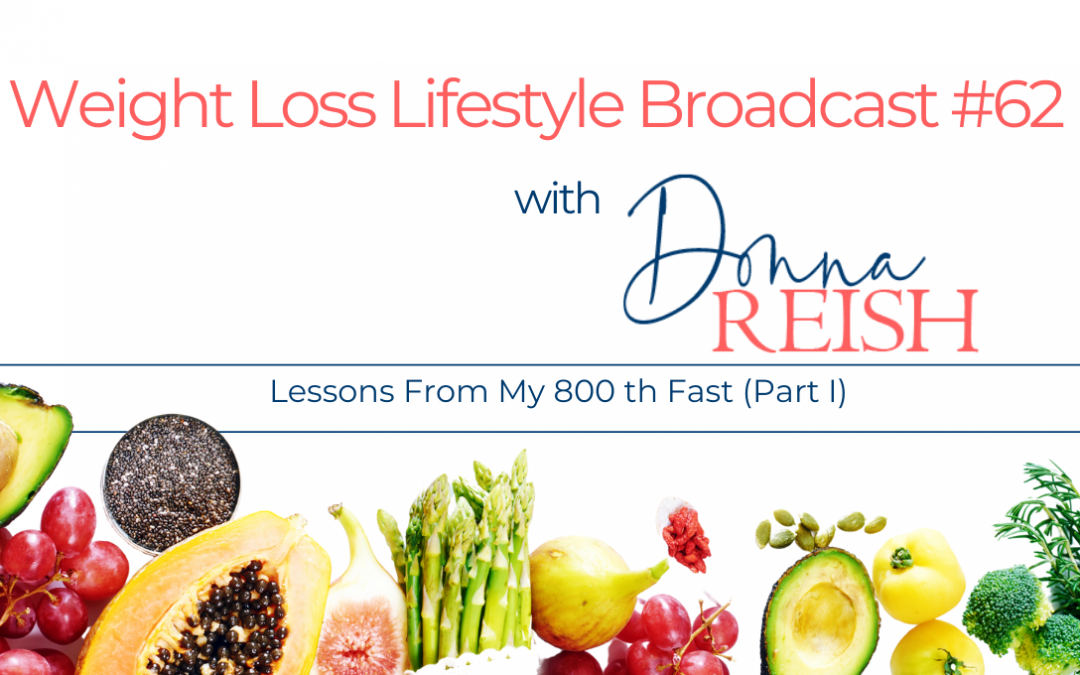
Weight Loss Lifestyle #62: Lessons From My 800th Fast (Part I)
Yay—my 800th fast!! This is gonna be festive! In this episode, I share about how my 800th fast showed up on the Zero app, what I like about the app, and how to use an app to reach your fasting goals. Then I delve into how I average my fasts for the week—and the...
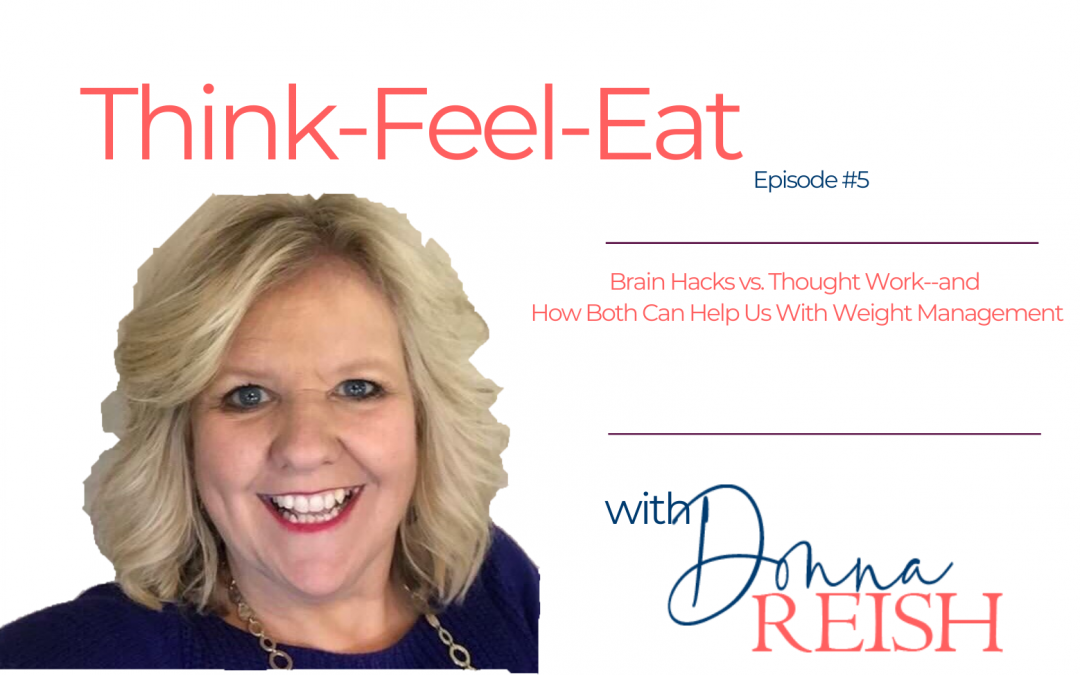
Think-Feel-Eat #5: Brain Hacks vs. Thought Work–and How Both Can Help Us With Weight Management
Hack your kitchen pantry system! Hack your bedroom closet organizing! Hack your vegetable cleaning and storage! Hack your vacation planning! And hack your brain? Yep...it's a real thing. And it is super powerful....and multi-faceted. To me, brain hacks are like...

Weight Loss Lifestyle #61: Willpower II–Ways to Overcome or Change the Willpower Gap
In Episode #60, I explained that we have a willpower gap---a gap between the amount of willpower that we need each day and the length of day/number of temptations we are faced with each day. We can do some things to manufacture more---we can refill some of our stores,...

Does “The Power of Positive Thinking” Work–and How Does Think-Feel-Act Differ From It? (Think-Feel-Eat Episode #4)
I have a little song that I like to sing to myself (you might only know the tune if you're, um...pretty "mature" lol). It's to the tune of "Catch a Falling Star and Put It In Your Pocket"! "Catch a helpful thought and put it in your pocket... Never let it fade away....

Broadcast #60 – The Problem With Relying on Willpower Part I of II
Why don't I have more willpower? Why can't I just be stronger around food? Why does food seem to control me? These were questions that I have asked myself for over forty years! So imagine my joy in discovering that the "lack of willpower" really wasn't my fault... And...

Think-Feel-Eat #3: Bullying Ourselves to Goal Weight With Negative Thoughts? Part II of II
Let's put this Think-Feel-Eat "Bully Thoughts" all together this week.... And let's start thinking better thoughts about ourselves so that we can feel better feelings... AND...take more productive actions. Even those who are completely new to thought work and...

Think-Feel-Eat #2 Bullying Ourselves to Goal Weight With Negative Thoughts? Part I of II
Can we think ourselves thin? Can we think ourselves fat? Well...yes and no! Our thoughts lead to our feelings...and they both yield actions. If we think negative thoughts about ourselves, essentially bullying ourselves into weight loss, we will have actions that do...

Think-Feel-Eat #1: Introducing the Self Coaching Model (The Think-Feel-Act Series)
This is the first episode of Think-Feel-Eat and is chock-full of valuable information for your weight loss journey–and for your life journey! Yep…I think it’s that impactful! In this broadcast, I introduce the first Thursday evening Model (recorded live in the...

Broadcast #59 – Live Q and A From the Intermittent Fasting Course
Broadcast #59 is a Q and A....and I am excited to share it with you! Just like all broadcasts, "it's gonna be festive"!!! It is actually a live Q and A from the Week Four of the January Intermittent Fasting Course....but the questions are so pertinent to all my...
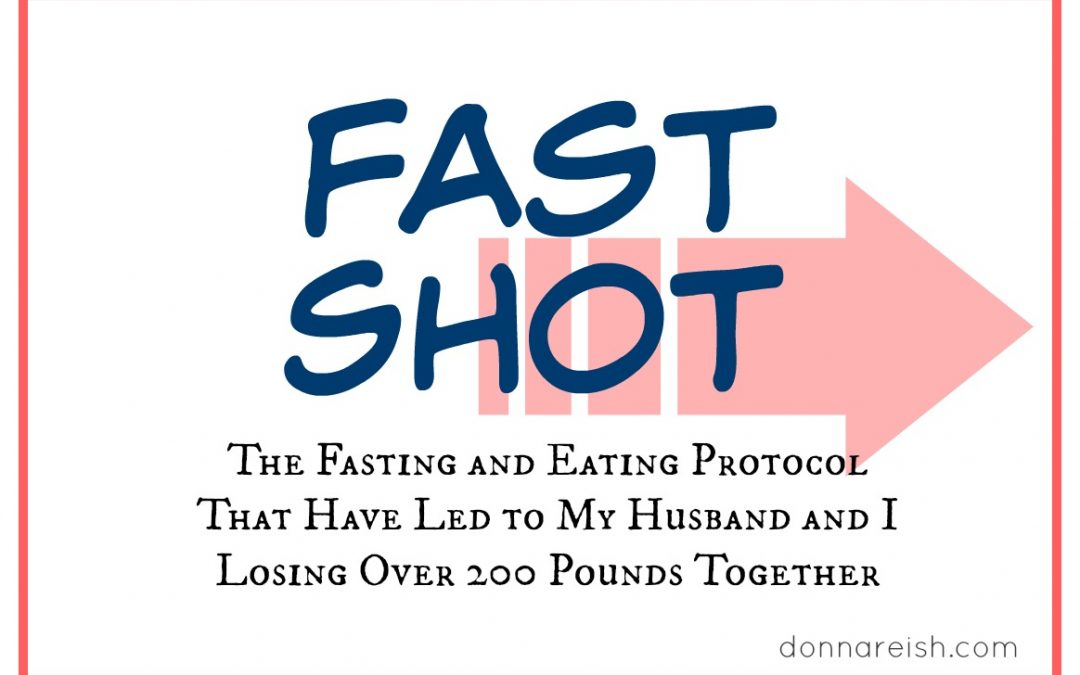
The Fasting and Eating Protocol That Have Led to My Husband and I Losing Over 200 Pounds Together (Fast Shot)
Today I take you "behind the scenes" to hear how Ray Baby and I began Intermittent Fasting two years ago--and the impact that this decision has had on us, including... +balancing blood sugar and insulin to reduce cravings +becoming fat adapted so hunger is almost non...

Goal Weight Identity Training (Free Download!)
If you have been in the free FB group for a while, you might have noticed two things: 1) I have changed the name!!! It used to be Donna's Intermittent Fasting Group...and it is now Weight Loss Lifestyle! I still teach about fasting all the time (check out my...

How Intermittent Fasting Helps Me Keep My Goals for the New Year! (Fast Shot)
Intermittent Fasting is the health and eating protocol that has led to my keeping my goals for the last two years--and has helped my husband I lose over 200 pounds together! IF helps me meet my goals by training my hunger hormones, helping me hear my satisfaction...
Mushroom-Spinach Egg Skillet
We made a new healthy egg skillet recently. Ray Baby loved it! Wasn’t exactly sure what to call it! Super easy and healthy! Rough steps: 1) “Stir fry” garlic, onion, and seasonings in chicken base, Worcestershire sauce, and red wine. (Can use olive, avocado, or...

Intermittent Fasting Journal #58 Introducing the Self Coaching Model (The Think-Feel-Act Series)
Broadcast #58 is alive and well! And chock-full of valuable information for your weight loss journey--and for your life journey! Yep...I think it's that impactful! In this broadcast, I introduce the first Thursday evening Model (recorded live in the FREE FB group...

How Many Special Unhealthy Food Occasions Do You REALLY Have Between Halloween and New Year’s Day? (Broadcast #57)
The thing about me is I get a little crazy---just a little--when I learn something new or find something that works for me. (You didn't know that already, did you? 🙂 ) And today's Broadcast is no exception.... I have learned so much since I began weight loss...
Plexus
Check out the supplements that have changed my life!
Ray & Donna Reish Independent Ambassadors #1382677

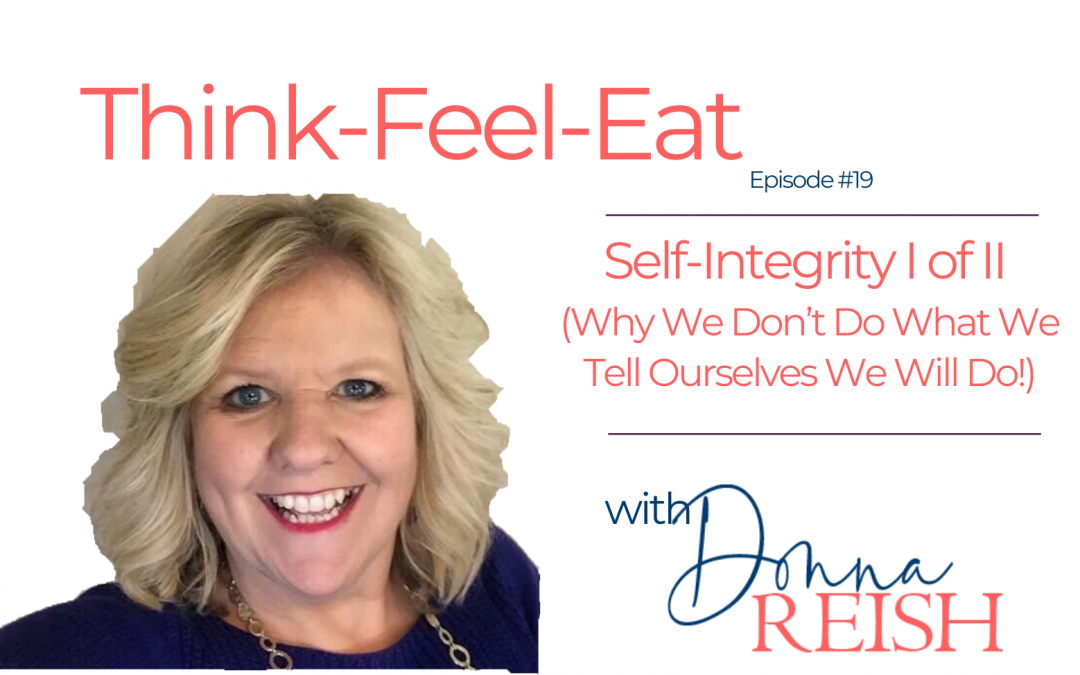
Think-Feel-Eat Episode #19: Self-Integrity I of II (Why We Don’t Do What We Tell Ourselves We Will Do!)
Hi! I’m Donna Reish, IF teacher, weight loss coach, blogger, and half of “The Minus 220 Pound Pair” as my husband and I have lost over 220 pounds together (160 of that in the past couple of years through the Weight Loss Lifestyle habits and strategies I teach!).
The next two episodes’ contents have been life changing for me! And I am happy to present them to you to help you change your life as well.
Not doing what we tell ourselves we will do is probably the greatest thief of our dreams and future life. And yet we do that over and over—and then scratch our heads in bewilderment as to why we don’t do what we tell ourselves we will do.
Come to find out, it isn’t our fault.
In Episode 19 of Think-Feel-Eat, I present several enemies of self-integrity. The bare bones of why we don’t do what we tell ourselves we will do.
(See Weight Loss Lifestyle #60 and #61 for my two Willpower Episodes….super empowering to know why we don’t have the willpower we think we should!)
These range from trusting willpower to get us through to being too vague to waiting until we are in the moment (and using our toddler brains to guide us!).
The good news is that all of these are over-come-able!
We can have self-integrity. And when we do, it will change our lives!
Self-integrity will change our size, weight, health, muscles, food, time management, relationships, home care, self care, work, and more!
As always, I have a full, detailed outline, an audio, and a video version. Start gaining self-integrity today!
Find all of my episodes, outlines, and articles for my two weekly broadcasts:
(1) Weight Loss Lifestyle broadcast (formerly Donna’s Intermittent Fasting Broadcast)
Sign up for my free webinar: intermittentfastingwebinar.com
TFE 19 Outline Self Integrity Part I of II (Why We Don’t Keep Our Word to Ourselves)
A. Defining and Understanding Self-Integrity
1. Definition: the quality of being truthful and honest with yourself, of intentionally aligning personal behaviors and actions to be congruently aligned with your own values and goals. It requires a commitment to align ourselves to stay consistent with personal values so that we do what we tell ourselves we will do.
2. Difficult because we are not answering to anyone but ourselves
3. Event people who are amazing in integrity with others often are not with themselves.
4. Self Integrity covers every area of our lives!!
a. Weight
b. Drugs/alcohol/nicotine
c. Pornography
d. Business/scheduling work
e. Family
f. Marriage
g. Shopping
B. Enemies of Self-Integrity
1. Thoughts about our past failures/Negative Self Talk
a. Thoughts about our past failures
i. When we bring in our past inconsistencies and lack of self-integrity, we can’t move into self integrity even with tools.
ii. Thoughts and words spoken like “I never do what I say I will do” or “I’ll probably just skip things this time too” or “I can never stay on an eating protocol, so I will probably do that again” will keep us from moving forward even if we do have the tools and the understanding of the processWords/thoughts about the hiddenness of self-integrity
b. Words/thoughts about the hiddenness of self-integrity
i. Nobody will know
ii. Must get to where we want to do it for us—that even if we were the only ones who know, we still want to do it
iii. In the meantime, we have to believe that when we don’t do what we say, it does matter (health, weight, income, time, etc)—that this thing I said I would do but now don’t want to do will truly affect me.
iv. Better Thought: My past self made this great plan for my current self!
2. Perfectionism
a. “Believing your life would be better if you were perfect and thus, should strive for that”
b. The way we deal with unmet perfectionism is to give up entirely—if we can’t do it perfectly, we just won’t do it.
c. It is common sense that five minutes of exercise is better than nothing or that staying on a protocol 75% of the time is better than not at all, but when we are stuck in perfectionism, we can’t think that through
d. Creates a vicious cycle: tomorrow I will do it perfectly; then we don’t; we beat ourselves up/belittle ourselves; we get relief by planning to d it perfectly the next time; rinse and repeat.
e. Perfectionism will be the biggest roadblock to our using the ABC tool by Fogg/Harris
f. A change a month yielded 360 changes for us over a 30+ year period of time!!!
3. Not breaking goals down/biting off too much
a. Often related to perfectionism
b. Sometimes we can’t see the little steps it takes to get to a big goal
c. Other times the little steps do not feel like they will get us there
d. We believe we should “play big or go home”
e. My bladder exercises—break it down because didn’t see how I could add another thing to my day.
4. Relying on willpower
a. When we don’t plan ahead and make decisions ahead of time, we leave the weight of any changes in our lives (or any self integrity issues) on the part of the brain that is ill-equipped to make those decisions and carry out the goals in our life
b. The amount, type, and intensity of willpower that is needed to do some things for some people are nearly impossible to override/sustain
c. Research shows we spend four hours per day resisting temptations
d. We have a willpower gap—the number of instances we need willpower is greater than the amount of willpower we have in any given day
e. See Weight Loss Lifestyles Episodes 60 and 61 for extensive willpower teaching.
5. Not planning/deciding ahead of time
a. Prefrontal cortex vs. toddler brain
b. Decision making processes are those done ahead, not in the moment
c. In the moment relies on willpower, which we are often short of
C. Get More Help!
1. The Perfect Storm of Weight Loss teaches the steps to create your own protocol and bring together all aspects of weight loss
2. Willpower Part I and II
3. Sign up for a free consult call to see if weight/time management/life coaching with me would help you meet your goals!
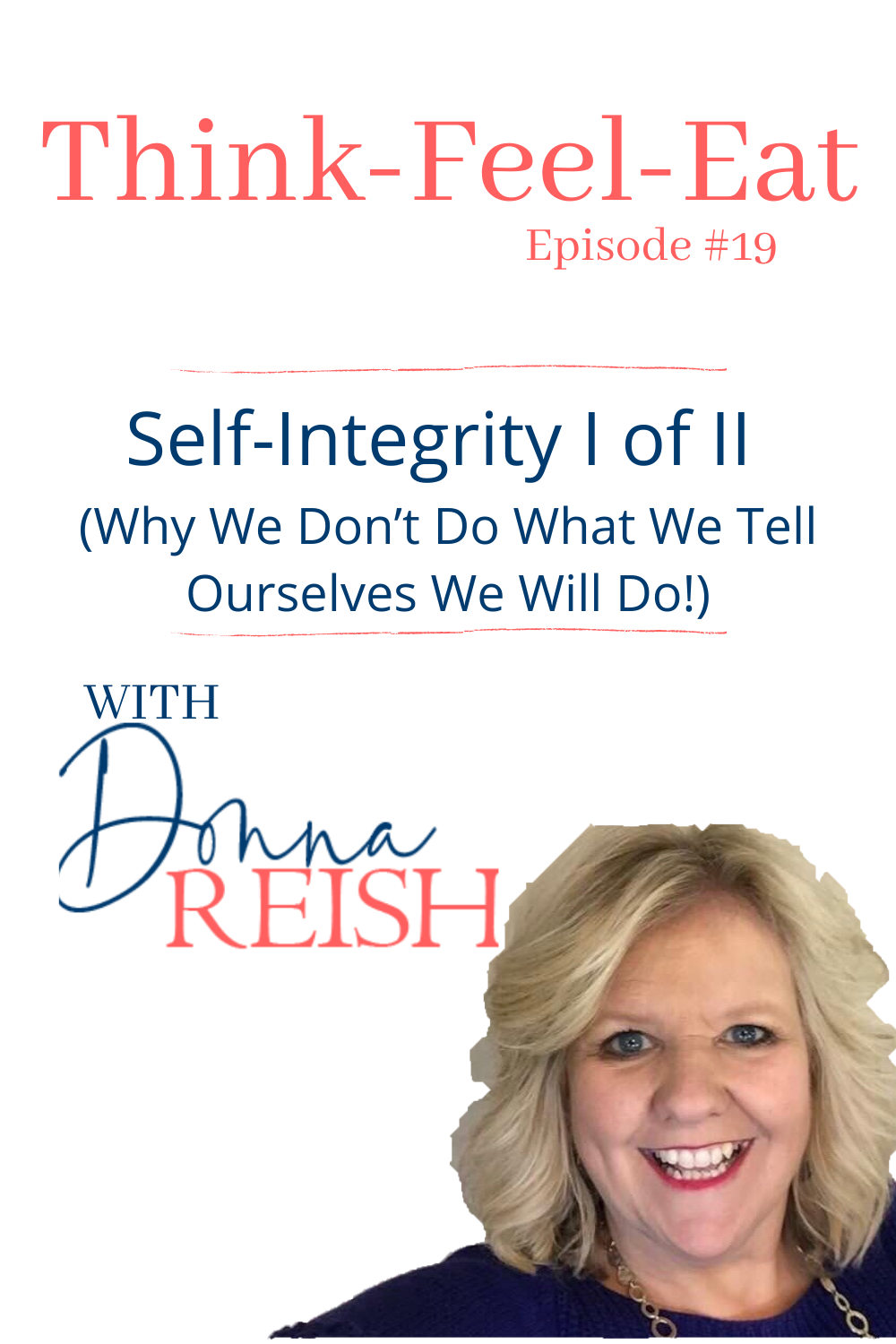

Think-Feel-Eat Episode #18: Pick-a-Protocol III (of III)
Hi! I’m Donna Reish, IF teacher, weight loss coach, blogger, and half of “The Minus 220 Pound Pair” as my husband and I have lost over 220 pounds together (160 of that in the past couple of years through the Weight Loss Lifestyle habits and strategies I teach!).
In this episode, I guide viewers and listeners in creating an Eating Protocol that works for them—and that fits into The Perfect Storm of Weight Loss for YOU!
In the first few protocol episodes (13, 14, 15), I taught the Foundations of Creating an Eating Protocol.
In this three-part episode, I teach about six different protocols and how they may or may not work for you—based on the three pillars of The Perfect Storm:
1) Eating Protocol (time, type, amount of food)
2) Hormones, brain chemicals, neurotransmitters
3) Thought and emotional management
Yep—it takes all three of these working in concert with each other to create the Perfect Storm!
In Episode #16 (Part I of Pick-a-Protocol), I taught about the first two of six on the Pick-a-Protocol chart: Keto and Calorie Counting With 80/20 (80% real food).
In Episode #17, I taught the next two popular (and effective) protocol options: Macro-Nutrient Counting and No Flour/No Sugar.
In this episode, I pick up on the next two protocols from the chart: Calories With Low Carb (not Keto) and WW Point System.
I explain how these protocols stack up in a number of ways—and how you can know if they would be good choices for you!
Find all of my episodes, outlines, and articles for my two weekly broadcasts:
(1) Weight Loss Lifestyle broadcast (formerly Donna’s Intermittent Fasting Broadcast)
Sign up for my free webinar: intermittentfastingwebinar.com
Click on the images below to download the documents from this episode!


Think-Feel-Eat Episode #17: Pick-a-Protocol II (of III)
Hi! I’m Donna Reish, IF teacher, weight loss coach, blogger, and half of “The Minus 220 Pound Pair” as my husband and I have lost over 220 pounds together (160 of that in the past couple of years through the Weight Loss Lifestyle habits and strategies I teach!).
In this episode, I present the introduction to the Perfect Storm of Weight Loss.
In this episode, I guide viewers and listeners in creating an Eating Protocol that works for them—and that fits into The Perfect Storm of Weight Loss for YOU!
In the first few protocol episodes (13, 14, 15), I taught the Foundations of Creating an Eating Protocol.
In this three-part episode, I teach about six different protocols and how they may or may not work for you—based on the three pillars of The Perfect Storm:
- Eating Protocol (time, type, amount of food)
- Hormones, brain chemicals, neurotransmitters
- Thought and emotional management
Yep—it takes all three of these working in concert with each other to create the Perfect Storm!
In Episode #16 (Part I of Pick-a-Protocol), I taught about the first two of six on the Pick-a-Protocol chart: Keto and Calorie Counting With 80/20 (80% real food).
In this episode, I pick up on the next two protocols from the chart: Calories With Macro-Nutrient Counting and No Flour, No Sugar.
I explain how these protocols stack up in a number of ways—and how you can know if they would be good choices for you!
Find all of my episodes, outlines, and articles for my two weekly broadcasts:
(1) Weight Loss Lifestyle broadcast (formerly Donna’s Intermittent Fasting Broadcast)
(2) Think-Feel-Eat broadcast at donnareish.com
Sign up for my free webinar: intermittentfastingwebinar.com
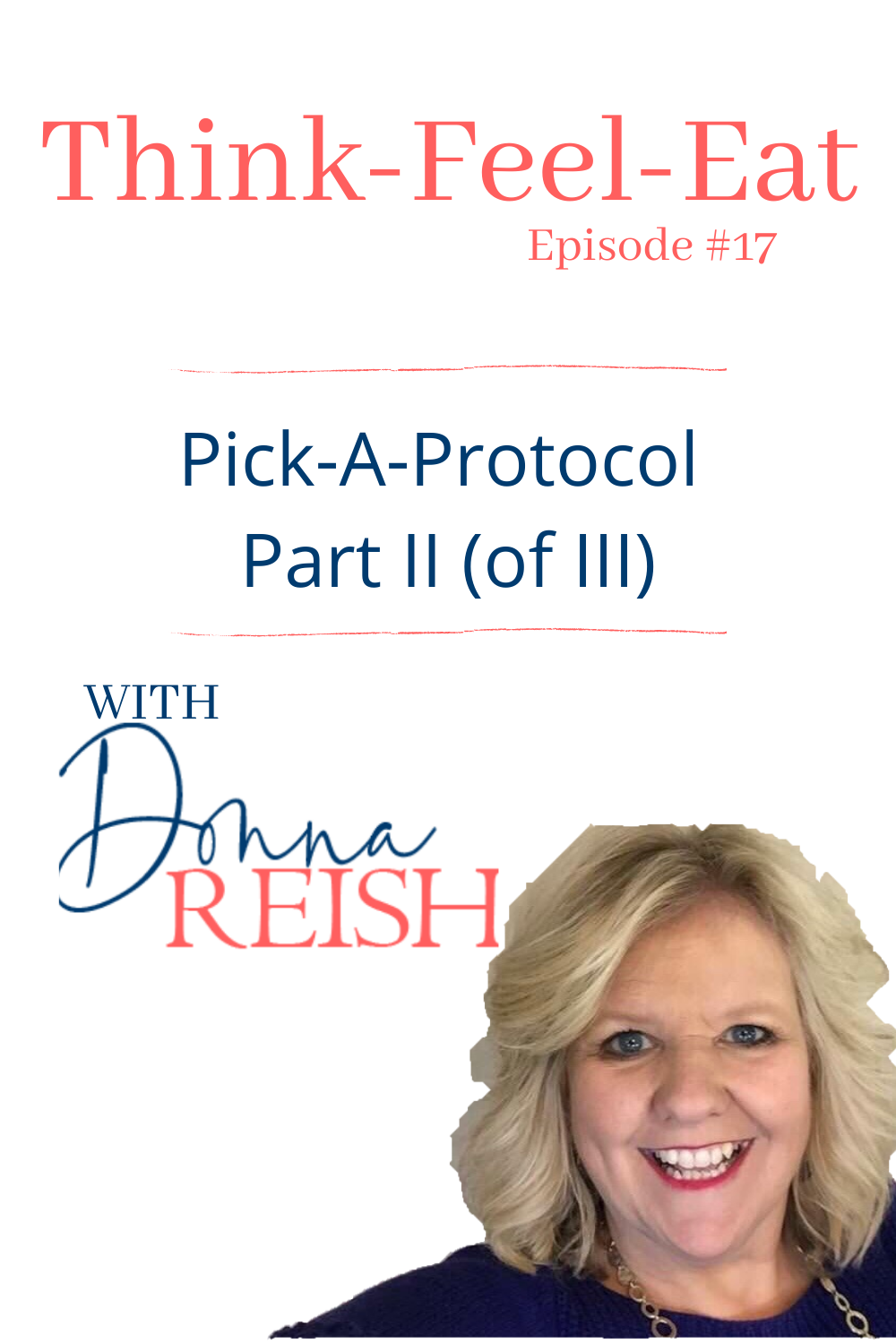
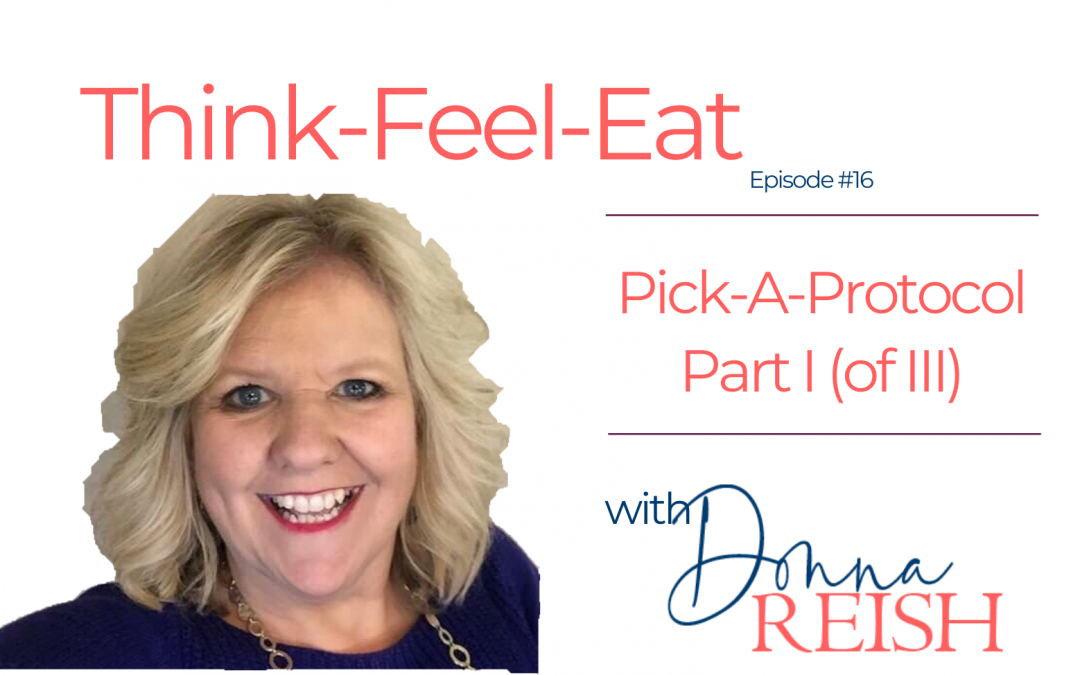
Think-Feel-Eat Episode #16: Pick-A-Protocol I (of III)
Hi! I’m Donna Reish, IF teacher, weight loss coach, blogger, and half of “The Minus 220 Pound Pair” as my husband and I have lost over 220 pounds together (160 of that in the past couple of years through the Weight Loss Lifestyle habits and strategies I teach!). In this episode, I present Part I of II of “Pick-a-Protocol.”
It’s time to get down to the nitty gritty! We have learned about the three elements of the Perfect Storm of Weight Loss (1) Food Protocol; (2) Hormones and Neurotransmitters; (3) Thoughts, Feelings, Habits, etc..
Yep…those three (and all of their many sub-parts!) make up the Perfect Storm of Weight Loss!
And today we “Pick Our Protocol”—or I should say, you “Pick Your Protocol”!
Picking Your Food Protocol will be easier for you if you have been watching the Think-Feel-Eat broadcasts, and you know what all you should consider…but even without that, I am going to be teaching about six different food protocols (with a thorough, helpful chart that you can get HERE!
I am going to talk about the major aspects of these six protocols:
1) Keto
2) Calories with Clear 80/20 boundaries
3) Macro-Nutrient Counting
4) No Flour/No Sugar
5) Calorie Counting With Low Carb (not Keto)
6) WW Point System
The aspects we will cover that I really feel someone needs to consider when making a decision about their protocol include (but are not limited to):
1. Do and don’t eat on that protocol
2. Must be willing to….. on that protocol
3. Complexity of that protocol
4. Adherence level for most people of that protocol (varies person by person)
5. Who usually likes that protocol (Good for….)
6. How it fits with IF
7.. Cortisol on that protocol
8. Dopamine on that protocol
9. Satisfaction/serotonin on that protocol
10. Costs involved in that protocol
Because all of those things really do matter when you are choosing a protocol!
Did I mention the chart? I found it so eye-opening as I created this chart and prepared this teaching. I think you will too!
I want so many good things for you!


Weight Loss Lifestyle #63: Macronutrients and Calories
Hi! I’m Donna Reish, IF teacher, weight loss coach, blogger, and half of “The Minus 220 Pound Pair” as my husband and I have lost over 200 pounds together (160 of that in the past couple of years through the Perfect Storm of Weight Loss strategies I teach!).
In this episode, I present an explanation of Macronutrients and Calories.
Macronutrients, also called macros, are the three main nutrients that make up calories. That’s the important point—macronutrients make up calories. Every calorie in food is comprised of grams of carbohydrates, proteins, and fats.
One macro at a time, I explain the major elements and facts of each, how food is comprised of them, and why we need them.
The first Macronutrient Venn diagram gives a big picture of how each macronutrient stands alone and how they overlap with each other. The second Macronutrient Venn diagram gives a listing of food for each macro, including the foods that are known for having two of the macronutrients in them (such as carbs and proteins in beans and fat and protein in fattier meats).
I created this “lesson” for my weight loss clients and those following my “Perfect Storm of Weight Loss” as I realized that many people think of low carb as being completely separate from calories or low fat as being completely separate from calories—not realizing that calories are made up of fat, carbs, and protein.
Find all of my episodes, outlines, and articles for my two weekly broadcasts:
(1) Weight Loss Lifestyle broadcast (formerly Donna’s Intermittent Fasting Broadcast)
(2) Think-Feel-Eat broadcast at donnareish.com
Sign up for my free webinar: intermittentfastingwebinar.com
I want so many good things for you!
Weight Loss Lifestyle #63: Macronutrients and Calories
A. What Are Macronutrients?
1. Often called “macros” in the fitness world
2. Three main nutrients that make up our food
3. They are BIG, thus called Macros (as opposed to vitamins and minerals, which are called micronutrients)
4. They make up our entire caloric intake each day (unless you drink alcohol; that is another calorie source)
5. Mathematically, your entire calorie consumption in a day comes from these three macros combined
i. Thus, if you increase calories, you increase macros
ii. If you decrease calories, you decrease macros
iii. If you cut back on a macro and do not replace it with another macro, you have just cut back on total calories
B. Protein
1. FOUR calories per gram of protein, so good macro for calorie counters
2. Considered most satiating macro because it helps you feel full longer since it is slow to digest
3. Known to rev up metabolism by 15-30% after consuming it
4. Most easily recognized by hunger hormones
5. Protein’s negatives are that best sources come from meats (and organic is expensive); too much can cause kidney damage; some sources are super fatty, which increases calories and can be less heart healthy
6. Good percentage for many people for weight loss is 35% or approximately .75 grams of protein per pound of body weight
7. Builds muscle and is a core component in organs, bones, and most tissues
8. Made up of amino acids
9. Essential amino acids are necessary and not made by body—must be eaten
10. Two types
a. Complete—no need to combine it with anything else to get full protein from it (example, animal protein)
b. Incomplete—needs combined with something else to get full protein from it (example, beans and vegetarian sources of protein)
11. Fatty proteins are part protein and part fat (some animal protein, dairy, nuts, salmon, eggs, nut butter, seeds)
12. Lean proteins will be all protein (egg whites, chicken, turkey, not fatty fish and seafood, plant and whey proteins, lean meats)
13. Can raise blood sugar/cause an insulin spike but not to the extent that carbohydrates do
14. Studies have shown that people who eat 30% of their calories in protein consumed 441 fewer calories than those who did not—satiating, long lasting, metabolism revving!
C. Carbohydrates
1. FOUR calories per gram of carbohydrate so good macro for calorie counters
2. Most easily accessible source of energy
3. Largest insulin spike of the three macros
4. Least satiating macro since it is turned into glucose or glycogen quickly and used for immediate energy (exceptions are slow digesting carbs and fibrous carbs)
5. Negatives associated with carbs are that they spike insulin and keep you in sugar burning rather than fat burning; most processed foods and snacky foods are high in carbs so many people do not get their carbs from real foods; processed carbs are addictive (because they spike insulin/blood sugar all the time and because the pleasure receptors in the brain are very affected by them); people eat too many carbs and not enough of the other macros, especially protein.
6. Good percentage for many people for weight loss (especially those who have had trouble losing weight) is around 25%. (This would be approximately 100-120 carbs per day for a person consuming 2000 calories.)
7. Brain needs glucose and will get it first from carbs then the other macros
8. Processed carbs are least satiating of all macros—leave stomach quickly, used easily for energy, not filling
9. Fiber is a type of carb that is folded into the total carb count on a nutritional label
10. Low carb people often subtract the fiber from the carbohydrate total since fiber isn’t digested in the same way as other carbs and doesn’t “count” in terms of insulin spiking. (People who count both calories and macronutrients do not subtract fiber from their carb calories.)
11. Two main types of carbs
i. Simple—short molecule chain=easier to break down and use quickly=sugar
ii. Complex—long molecule chain=harder to break down=starch
D. Fat
1. NINE calories per gram of fat so not good macro for calorie counters (when only considering calories alone)
2. More satiating than carbs because they stay in the gut longer (ghrelin isn’t spiked as much since stomach has something in it for a while)
3. In terms of sheer calories, fat should be more satiating than the other two because they contain 2x (plus) the number of calories per gram than protein and carbs
4. Smallest insulin spike of all three macros
5. Negatives associated with fat are that people eat too many unhealthy fats that cause heart issues, blood pressure issues, etc.; that they are calorie heavy, so eating too many fat grams simply gives you too many calories for the day; people often eat trans fats in packaged foods (and the carbs in these lead to cravings)
6. The basis for the keto diet—75% carbs so keto people have to rely on fat bombs, butter on meat, cream and oil and butter in coffee, etc., for most of their calories
7. Trans fats are the worst fats to consume for heart health and are found in packaged foods
8. Fats are found with protein in fatty meats, dairy, nuts, eggs, salmon, chicken skin, nut butters, and seeds
9. Fats are found alone in butter, oils, avocados, and olives
10. Most important fats are fatty acids that the body doesn’t produce
i. Omega 3’s—from fatty fish
ii. Omega 6’s—from healthy oils
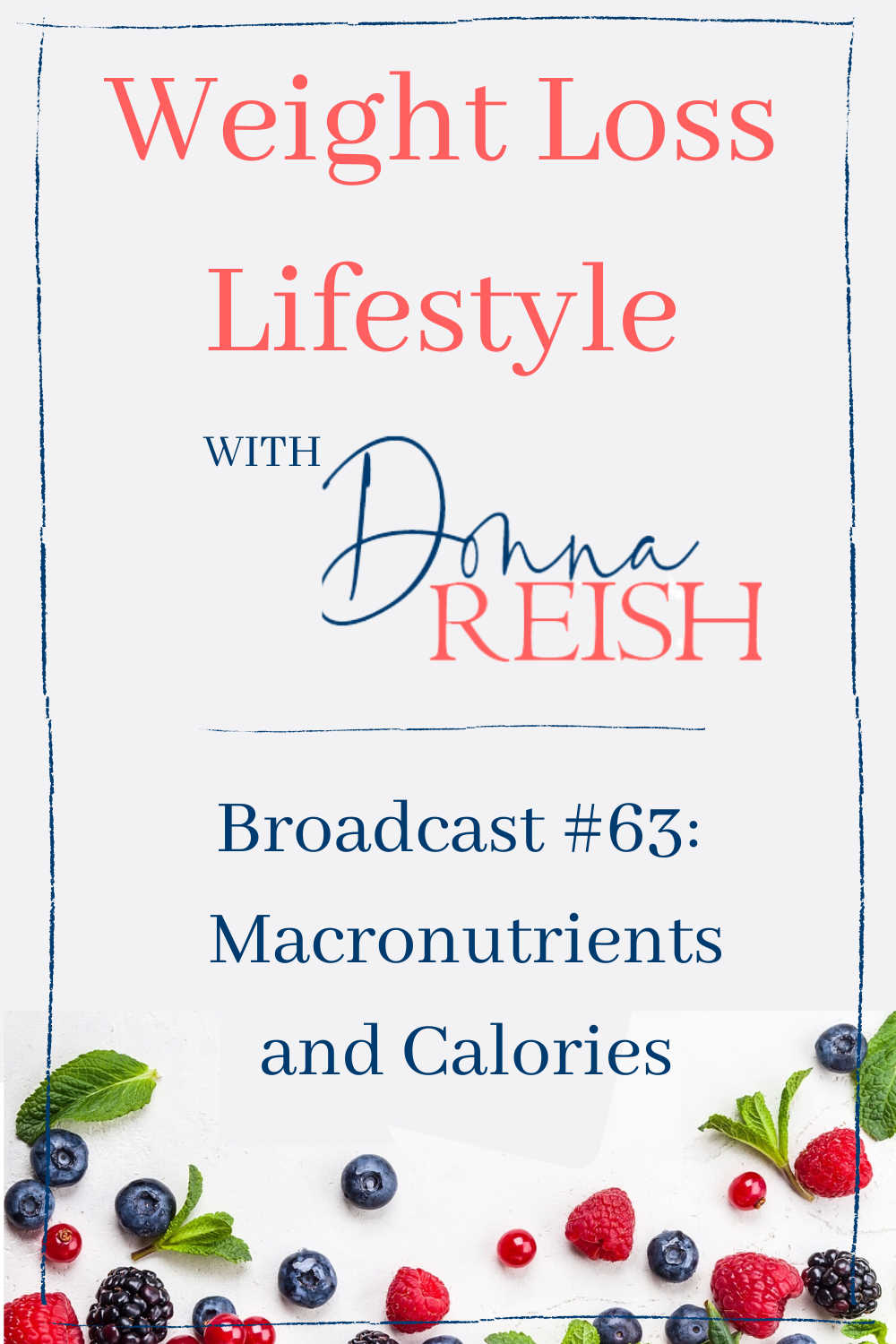

Think-Feel-Eat Episode #15: Four Food Types (and the 80/20 Food Rule)
Hi! I’m Donna Reish, IF teacher, weight loss coach, blogger, and half of “The Minus 220 Pound Pair” as my husband and I have lost over 220 pounds together (160 of that in the past couple of years through the Weight Loss Lifestyle habits and strategies I teach!). In this episode, I present the introduction to the Perfect Storm of Weight Loss.
In this episode, I continue to teach about creating your Eating Protocol for the Perfect Storm of Weight Loss starting with a review of the Perfect Storm and how all three aspects of the perfect storm are interrelated.
I then remind us what we already know about a strong eating protocol: what we eat affects how well we can stay on our protocol; habits affect how well we can stay on our protocol; our thoughts affect how well we can stay on our protocol.
We also know that fasting and deciding ahead of time help us stay on our protocol.
I use the mantra “Don’t take a bite until I write” every day. This means that I can’t eat anything until I have decided what my two meals will contain—right down to the time, the amount, the types, etc. while prioritizing protein and not exceeding what my body needs in order to either maintain or lose (depending on goal).
Our protocol will help us succeed when…
a. It is food we like
b. It gives us a metabolic boost like protein does.
c. It is low on junk food
d. Put big rocks in your jar first—your real foods, your satiating foods, your protein, etc.
e. It gives us fiber—Fx3= Fluffy, Fibrous, and Fluidy
Next I went into detail about the Four Food Types: Fuel Food (80% each day); Fun Food (20% each day); Frenzied Food (want to avoid), Fog Food (want to avoid). I describe how to divide up your food into the 80/20—and how to avoid Frenzied Food and Fog Food.
We must decide ahead of time what we are eating—and we must fill 80% of our foods with FUEL foods. We must plan our 20% of Fun Food each day and be sure that it isn’t Fabulously Fun Food (too high dopamine spike, too calorie dense, save for special occasions only).
Check out past episodes in order: donnareish.com/perfectstorm
Think Feel Eat Outline Episode 15: Four Food Types (and the 80/20 Food Rule)
A. Review of the Perfect Storm
1. Seeing how all three aspects are interrelated
2. All three aspects cause all diet success and failure
3. Focusing on only one aspect keeps us stuck in weight loss spinning
4. Exercise not the best means to lose weight
a. Self sabotage—running 30-40 miles a week for six months with no weight loss (should have lost a pound a week)—research shows that we usually eat more than any exercise burn gave us
b. Exercise causes us to think we can eat more—either subconsciously or consciously
c. Don’t rely on exercise to create your defiicit
d. Exercise is for….muscle building, metabolism boosting, mood enhancing, habit formation, shape of your body, clothes fitting, how you look, self integrity, serotonin, oxytocin, etc…..so much goodness!
e. Don’t count on it for weight loss—use it for the reasons above…and use it all the time. Movement is amazing!
B. What Do We Already Know About Creating an Eating Protocol?
1. WHAT we eat affects how well we can stay on our protocol
2. Habits affect how well we can stay on our protocol
3. Thoughts help us stay in control of food—rather than trying to use willpower or white knuckling
4. Fasting helps us control our hunger as we develop clock hunger
5. “Don’t take a bite until I write”—must write down what I am going to eat for that day the night before or the morning of—when I am thinking with my pre-frontal cortext not my toddler brain
6. Overeating, over desire, over hunger, craving, indulging, bingeing…food is what makes us fat.
7. A diet plan alone (that doesn’t consider creating a deficit in your food intake and that doesn’t teach you what to do with cravings and over desire, etc.) will usually not lead to goal—or it won’t keep you there if it does lead to goal through white knuckling.
8. “We propel what we plan. We move what we measure.” EVERY SINGLE DAY.
9. Our protocol will help us succeed when…
a. It is food we like
b. It gives us a metabolic boost like protein does.
c. It is low on junk food
d. Put big rocks in your jar first—your real foods, your satiating foods, your protein, etc.
e. It gives us fiber—Fx3= Fluffy, Fibrous, and Fluidy
10. Calories in check PLUS another boundary that keeps you eating more real food
11. Protocol must be something that you do not need to cheat on all the time. (One Fun Food Meal a week overall and one fun food within your protocol each day will not be considered cheating—you don’t want a protocol that you need to cheat on!)
C. Four Food Types
1. Fuel Food
2. Fun Food
a. Make your rules
b. Not fabulously fun foods!
c. The less seductive your Fun Foods are, the fewer cravings you’ll have and the better you can stay on your protocol
3. Frenzied Food
a. Eat fast before you think
b. Grab without thinking
c. Trick yourself
d. Often say something quickly to yourself like “I don’t care” or “This won’t matter” or “It won’t impact my weight”!
4. Fog Food
a. Truly in a fog with food
b. Not measured, so often it is an overeating of allowed food
c. When barriers and boundaries are not in place
D. We Can Do This!!
1. Check out my up and coming page that I use with my private coaching clients (you can use it on your own—let me know if you want to set up a free consult call to see if coaching is right for you!). This page has all of the elements we’ve discussed so far in the Perfect Storm! donnareish.com/perfectstorm
2. Set up a free consult—I’d love to talk with you! No charge. No pressure! https://donnareish.com/coachingpackages/


Think-Feel-Eat Episode #14: Foundations of Your Food Protocol Part II
Hi! I’m Donna Reish, IF teacher, weight loss coach, blogger, and half of “The Minus 220 Pound Pair” as my husband and I have lost over 220 pounds together (160 of that in the past couple of years through the Weight Loss Lifestyle habits and strategies I teach!). In this episode, I present the introduction to the Perfect Storm of Weight Loss.
The Perfect Storm of Weight Loss has three components. They are not steps. They are interrelated aspects. They each affect the other.
We start with Food—in this Foundations of My Food Protocol Part I—because our weight loss will be heavily influenced by FOOD—1) Time we eat food; 2) Type of food we eat; 3) Amount of food we eat.
But, again, the three aspects are related to each other—the Food we choose affects our dopamine, our cravings, our willpower, and our amounts.
The Time we choose to eat in affects our hormones, our hunger, and our satiety.
The Amounts we choose to eat will affect our ability to keep our Time in check—and which foods we choose. (My husband likes larger amounts of food, so his food choices have to be more narrow than mine!)
All interrelated. All creating the Perfect Storm of Weight Loss.
In today’s episode, I continue laying the foundation for your food protocol. YOU will choose your protocol. You decide all three aspects of your Eating Protocol (time, type, amount).
I will help you do this as we examine the three interrelated aspects of The Perfect Storm. You want your Eating Protocol (your time, types, and amounts) to get you the intake needed for your right sized body:
1. Without creating over hunger
2. Without creating over desire
3. Without increasing cortisol
4. Without decreasing serotonin/joy
5. Without eating foods you don’t like
6. Without eating over 20% Fun Foods
7. Without taxing your energy
8. Without having an empty stomach too much during eating window
9. Without increasing dopamine spikes around hyper palatable foods
10. Without disrupting sleep
Find all of my episodes, outlines, and articles for my two weekly broadcasts:
(1) Weight Loss Lifestyle broadcast (formerly Donna’s Intermittent Fasting Broadcast) and
(2) Think-Feel-Eat broadcast at donnareish.com
Sign up for my free webinar: intermittentfastingwebinar.com
Think Feel Eat Episode 14 Outline: Foundations of Your Protocol, Part II
A. Perfect Storm Review
- What does it take to create an eating protocol that leads to the Perfect Storm of Weight Loss? All three aspects of the triangle
- Number one—Eating Protocol (time, types of food, amounts of food
- Number two—Hunger, Cravings, Hormones, and Chemicals
- Thoughts and Emotions Management
- All three aspects are interrelated; they each affect the other.

B. Goal for the Perfect Storm Eating Protocol

1. Without creating over hunger
2. Without creating over desire
3. Without increasing cortisol
4. Without decreasing serotonin/joy
5. Without eating foods you don’t like
6. Without eating over 20% Fun Foods
7. Without taxing your energy
8. Without having an empty stomach too much during eating window
9. Without increasing dopamine spikes around hyper palatable foods
10. Without disrupting sleep
C. What Will Get Us to Goal?
1. We can lose weight at first (when we have quite a bit to lose) with a smaller deficit—this is why nearly EVERYTHING works when we first start a diet.
2. There are those protocols that are less likely to get you to goal because they don’t consider dopamine spikes, stomach fullness, hunger, cravings, etc.
3. Other protocols that consider overall calories along with considering types of foods, amounts of food, times, etc., will likely get you to goal better.
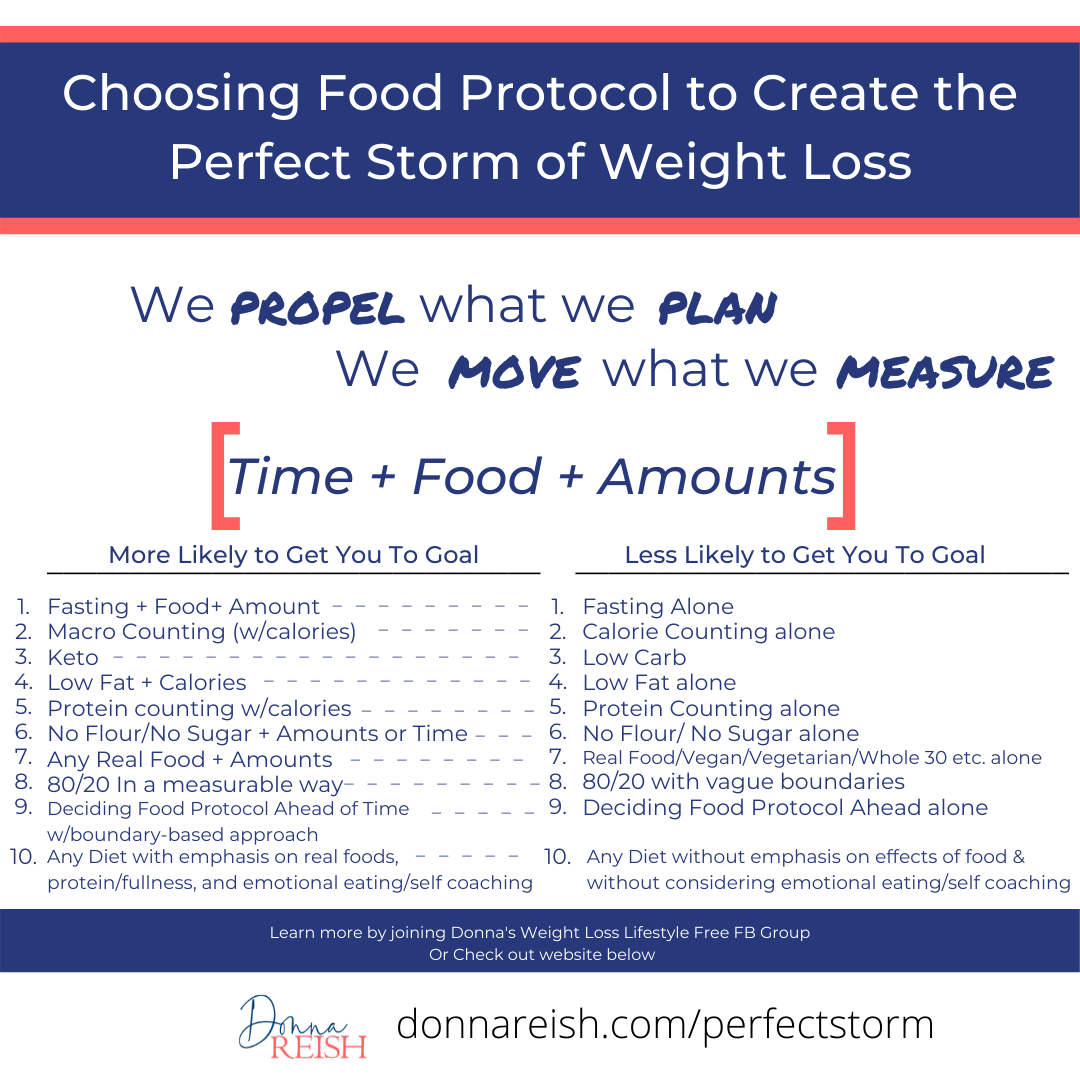
D. Productivity, Weight, Life Coaching Now Open!
1. Founding Members Half Price Special Until June 15th
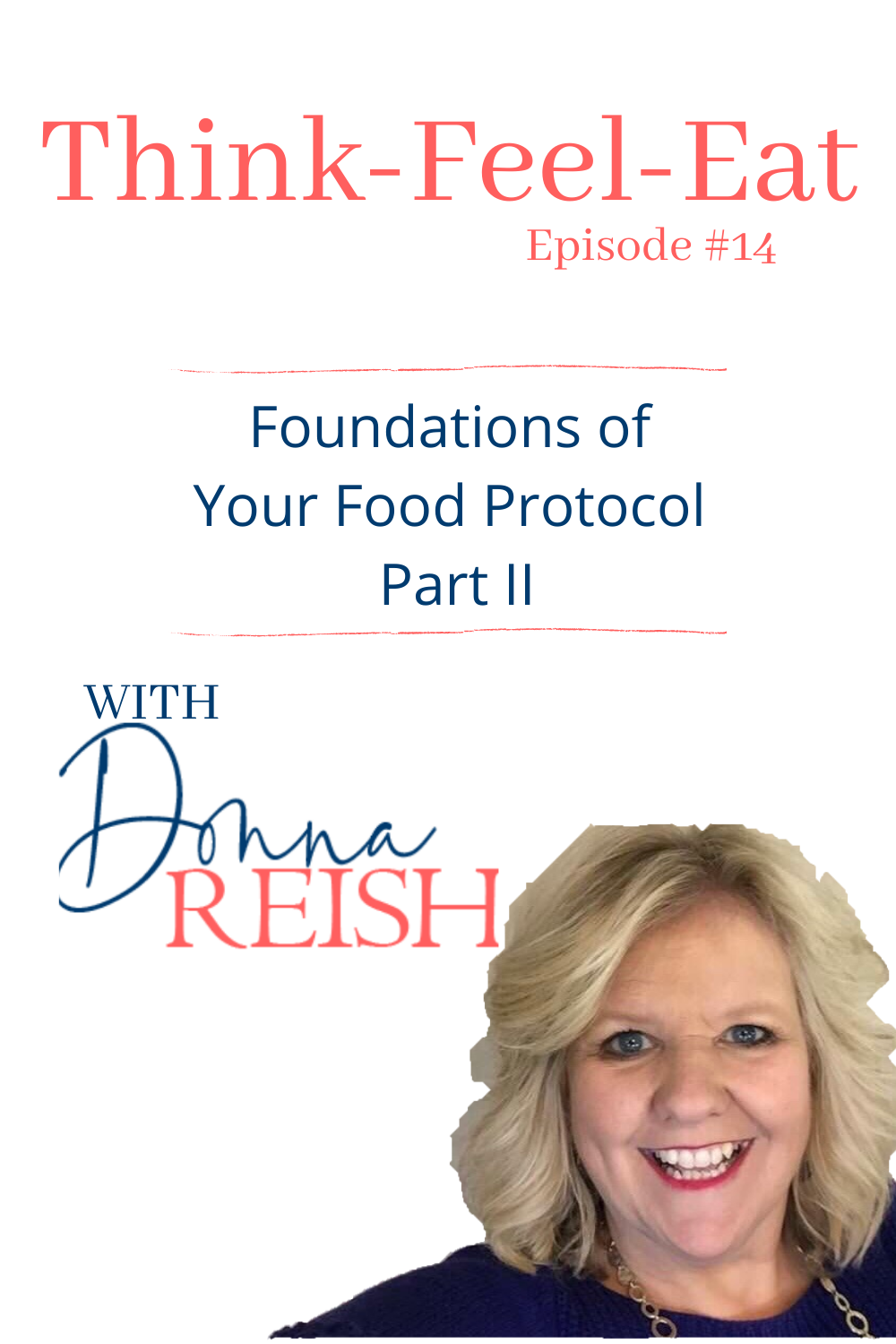

Think-Feel-Eat Episode #13: Foundations of Your Food Protocol Part I
Hi! I’m Donna Reish, IF teacher, weight loss coach, blogger, and half of “The Minus 220 Pound Pair” as my husband and I have lost over 200 pounds together (160 of that in the past couple of years through the Weight Loss Lifestyle habits and strategies I teach!).
In this episode, I present the introduction to the Perfect Storm of Weight Loss.
The Perfect Storm of Weight Loss has three components. They are not steps. They are interrelated aspects. They each affect the other.
We start with Food—in this Foundations of My Food Protocol Part I—because our weight loss will be heavily influenced by FOOD—
1) Time we eat food;
2) Type of food we eat;
3) Amount of food we eat.
But, again, the three aspects are related to each other—the Food we choose affects our dopamine, our cravings, our willpower, and our amounts.
The Time we choose to eat in affects our hormones, our hunger, and our satiety.
The Amounts we choose to eat will affect our ability to keep our Time in check—and which foods we choose. (My husband likes larger amounts of food, so his food choices have to be more narrow than mine!)
All interrelated. All creating the Perfect Storm of Weight Loss.
In today’s episode, I start laying the foundation for your food protocol. YOU will choose your protocol. You decide all three aspects of your Eating Protocol (time, type, amount).
But you need to consider several things before you do that. So I am starting to dig in on this episode to how the three parts of the Perfect Storm of Weight Loss are connected—and what all we need to consider in developing your Food Protocol.
This will be different than joining a diet.
You are going to choose what works for you—based on the three pillars of the Perfect Storm of Weight Loss.
Thanks for joining me!
This “Perfect Storm” is the same method I use with my weight loss coaching clients! Set up a consult to see if weight loss/life coaching with me is a good move for you at donnareish.com/coach
Find all of my episodes, outlines, and articles for my two weekly broadcasts:
(1) Weight Loss Lifestyle broadcast (formerly Donna’s Intermittent Fasting Broadcast) and
(2) Think-Feel-Eat broadcast at donnareish.com
Sign up for my free webinar: intermittentfastingwebinar.com
Think Feel Eat Episode 13 Outline: Foundations of Your Protocol, Part I
A. Perfect Storm Review

B. Foundations of Your Protocol
1. Has to be something that brings all three aspects of the Perfect Storm Triangle together
2. We PROPEL what we PLAN; we MOVE what we MEASURE.

3. My story of having the FEELING of Curiosity—THOUGHT: I can find something that works for me; FEELING: CURIOSITY.
C. Choosing Food Protocol to Create the Perfect Storm of Weight Loss
1. Can you stay on it?
2. Do you lose on it?
3. Do you like the food?
4. Don’t sign up for the program because it worked for someone else or you lost on it before (even though you didn’t like the food).
5. Effects of fasting on weight loss

D. Closing: I Can Help You!
1. Perfect Storm of Weight Loss Page: donnareish.com/perfectstorm
2. Weight loss coaching: donnareish.com

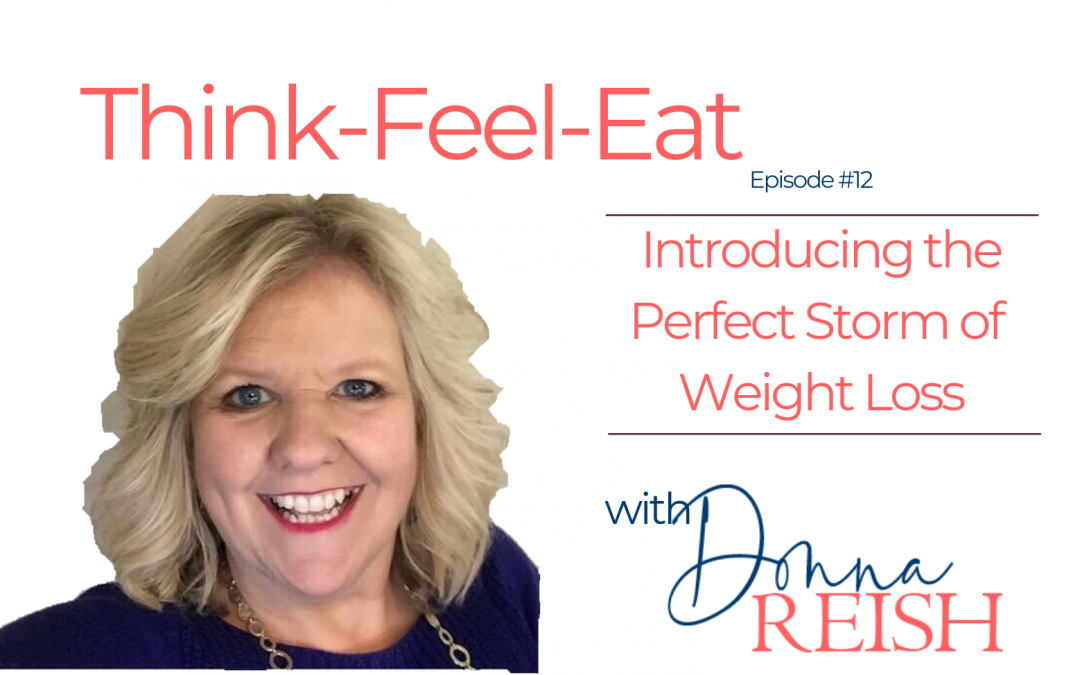
Think-Feel-Eat Episode #12: Introducing the Perfect Storm of Weight Loss!
Hi! I’m Donna Reish, IF teacher, weight loss coach, blogger, and half of “The Minus 220 Pound Pair” as my husband and I have lost over 200 pounds together (160 of that in the past couple of years through the Weight Loss Lifestyle habits and strategies I teach!).
In this episode, I am excited to present the introduction to the Perfect Storm of Weight Loss.
I begin by defining a “perfect storm” and how we can apply this to weight loss and weight management. Rather than being a “violent storm” that occurs from a combination of conditions, the “Perfect Storm of Weight Loss” is a “predictable storm” that occurs from a combination of conditions that we can have control over.
Weight loss isn’t simply a calorie deficit or an eating protocol or eliminating foods. Weight MANAGEMENT—that is losing to a healthy weight and keeping it off—is a series of many things that we can INCREMENTALLY control. So cool!
I give my “propel what you plan” and “move what you measure” speech—nothing happens to us in weight loss—we make it happen by planning ahead and measuring/reviewing what is and isn’t working.
Finally, I introduce “The Perfect Storm of Weight Loss” Triangle—where we can see the three main aspects of weight loss/management and how they interact with each other.
I’m excited about this series—it will eventually come with a podcast/broadcast roadmap, “The Perform Storm of Weight Loss” in which the podcasts/broadcasts are laid out for you with their outlines in the order that will help you have the most success!
Keep abreast of the elements of the Perfect Storm here: donnareish.com/perfectstorm
This “Perfect Storm” is the same method I use with my weight loss coaching clients! Set up a consult to see if weight loss/life coaching with me is a good move for you at https://donnareish.com/coach
Find all of my episodes, outlines, and articles for my two weekly broadcasts:
(1) Weight Loss Lifestyle broadcast (formerly Donna’s Intermittent Fasting Broadcast) and
(2) Think-Feel-Eat broadcasts at donnareish.com
Sign up for my free webinar: intermittentfastingwebinar.com
I want so many good things for you!
Think Feel Eat Episode 12 Outline: Introducing the Perfect Storm of Weight Loss
A. What Is the Perfect Storm of Weight Loss
1. Definition
a. PERFECT STORM: “A particularly violent storm arising from a rare combination of adverse meteorological factors.”
b. PERFECT STORM OF WEIGHT LOSS: “A particularly productive weight management “storm” arising from a predictable combination of positive physiological, brain, thought, hormonal, food, emotional, and habit factors.”

2. What we think
a. We think it is the perfect diet—we think it is something that we can stick to, suffer through, not fall off….until we lose the amount of weight we need or want to lose
b. We think it is something that someone else is doing that is working or something that has worked for us before (which could both be true!)
3. It doesn’t have to be that way. We can create our own Perfect Storm—with a way that we will enjoy our foods, be satisfied with the amounts, and live comfortably with the time. We can do this!

B. What If We Really Do Have to “Change Everything”?
1. We don’t have to eat foods we hate or fast longer than we are comfortable or eat tiny portions that don’t satisfy us.
2. But we will make drastic changes over time—but they won’t seem drastic as we make them slowly and comfortably….it’s pretty amazing!
3. Weight loss is not just one single plan or approach—most research shows that ANY plan will work (people lose to goal on the potato diet, the Twinkie diet, the carnivore diet, the egg diet, the fat diet, the 600 calorie diet, and on and on and on…from the most unhealthy approaches to more sensible ones)
a. One commonality—they reduce intake. Period
b. Most widely outcome of weight loss research shows that most of us need to lose 30% of our body weight and eat 30% less than we do. Period.
c. How we create the Perfect Storm is up to us—and has to be something we can do forever (or some form of it—we will “asses/measure” and tweak as we go).

C. We must PLAN and MEASURE…
1. We PROPEL what we PLAN and we MOVE what we MEASURE…
2. Planning means that we decide ahead of time with the adult portion of our brain what we can live with for our Eating Protocol (time, foods, and amounts)
3. Measuring means we assess what we are doing and make changes as needed


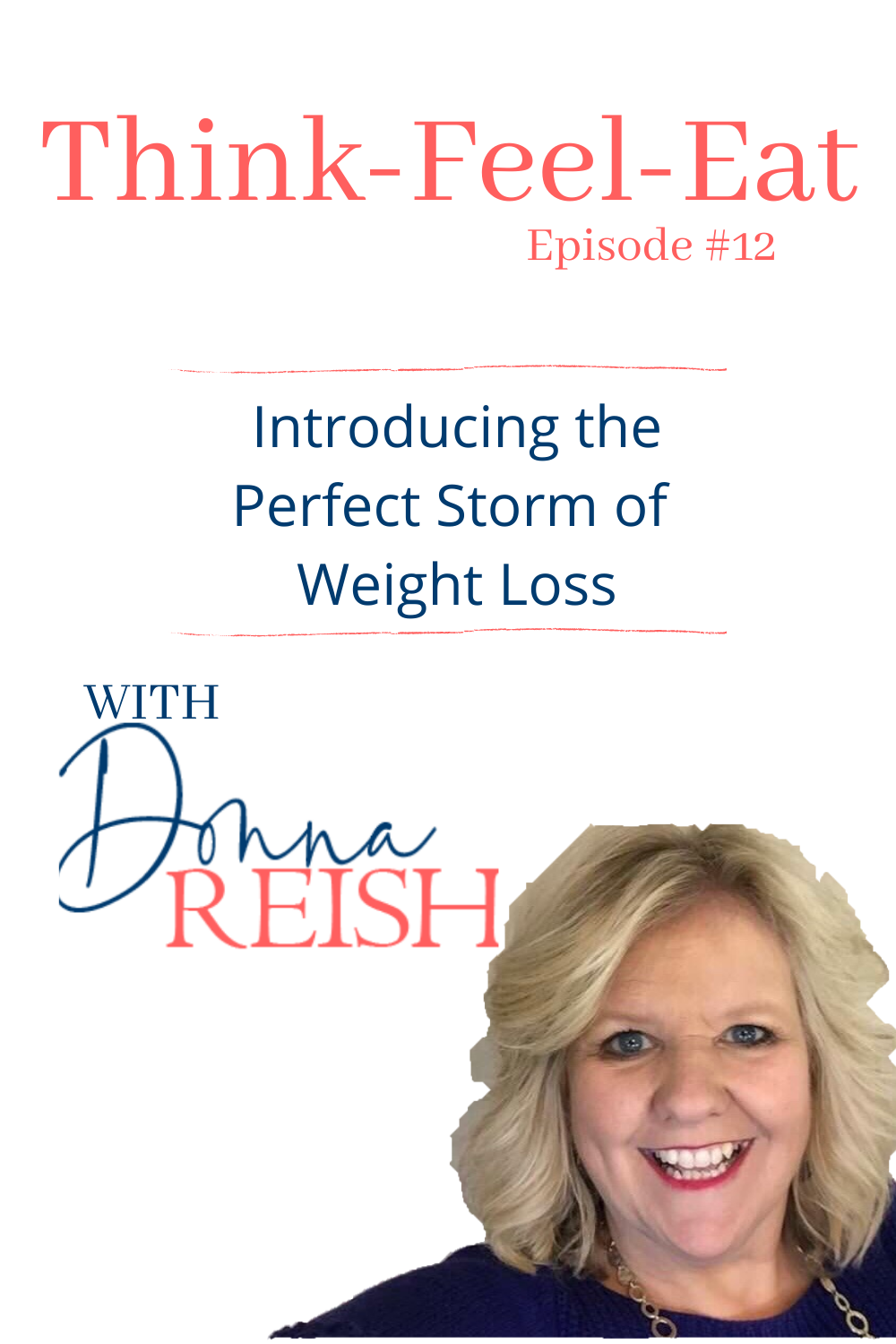

Think-Feel-Eat Episode #11: Introducing the Eating Protocol
Hi! I’m Donna Reish, IF teacher, weight loss coach, blogger, and half of “The Minus 220 Pound Pair” as my husband and I have lost over 200 pounds together (160 of that in the past couple of years through the Weight Loss Lifestyle habits and strategies I teach!).
In this episode, I present the introduction to Creating an Eating Protocol. This is the first video/audio in a several-week series. (In this series, you will learn how to put a protocol in place that works for you—that you don’t hate or dread, that reduces food urges. that you can do forever….)
Today I introduce the concept of an Eating Protocol—a protocol that you create for yourself that has you determine WHEN you will eat (fasting and eating windows); the FOODS you will eat (food protocol); and the AMOUNTS you will eat (how much).
Creating an Eating Protocol is not just following a diet. It is deciding for yourself what you can do (even in a Pandemic!) and that gives you the results you are seeking. It is taking control of your eating time, foods, and amounts. It is freeing and life changing!
After I introduced the concept of an Eating Protocol (not a Perfect Protocol—even a Pandemic Protocol will help!), in this episode, I taught the first part of the Eating Protocol: TIME. We can start fasting, restart fasting, or increase our fasting—whatever we want to do for ourselves. (Take my free webinar this week or next: intermittentfastingwebinar.com)
I then leave listeners with some Food Protocol questions for next week….what do all food plans/diets have in common? What worked for you for weight loss before? What can you do right now?
I’m excited to help you with this material! It’s gonna be festive!
Find all of my episodes, outlines, and articles for my two weekly broadcasts:
(1) Weight Loss Lifestyle broadcast (formerly Donna’s Intermittent Fasting Broadcast) and
(2) Think-Feel-Eat broadcast at donnareish.com
Sign up for my free webinar: intermittentfastingwebinar.com
INTRODUCING THE EATING PROTOCOL
A. Elephant in the Room With IF
1. IF magical weight loss—without any food restrictions?
2. IF is an amazing tool in our tool belt—one that brings us constraint; one that balances hormones; one that brings in boundaries for us
3. Who do you know who got to their goal with IF as part of their weight loss journey but didn’t change anything else?
4. At first, any deficit you create (reducing intake by fasting) will cause weight loss
B. Why a Protocol now?
1. We are desperate for some control in our lives
2. We can create a protocol that works right now—a Pandemic Protocol not a Perfect Protocol
3. We don’t have the willpower for strict food changes right now because we are using our small stores of willpower to LIVE during this time (See Weight Loss Lifestyle #60 and #61 for Willpower Training!)
4. If we don’t think ALL or NOTHING, then we can create a Pandemic Protocol for Eating….it’s only when we think everything has to be perfect (including our protocol!) that we don’t want to create a protocol.
5. Isn’t some control better than no control?
a. Weight management is better than weight gain!
b. We don’t have to lose weight, but what if we could come out of the pandemic having not gained weight???
6. What if we can design a protocol during this time that helps us feel all of our feelings, process them, eat better—one that we don’t have to buffer against?
7. What if we could design a protocol you can really live with, one in which you don’t buffer with off-protocol foods in order to stay on it?
8. Can we NOT be all or nothing people during this time? YES! We can.
C. What Is an Eating Protocol?
1. Has three components (see graphic)
a. Deciding a TIME protocol—WHEN you will eat most days
b. Deciding a FOOD protocol—WHAT you will eat most days
c. Deciding an AMOUNT protocol—HOW MUCH you will eat most days
2. You can’t know if you’re ON your plan or OFF your plan if you don’t have a plan—
a. We PROPEL what we PLAN
b. We MOVE what we MEASURE
3. Check out TFE Episodes 7, 8, and 9 for Cravings and Urges teaching
4. An Eating Protocol will change your life!
a. Will create the perfect storm of weight loss
b. Will be what you can live with/do to get to your goals
D. Part I of Eating Protocol: Decide WHEN You Will Eat Most Days (TIME)
1. Start with what you can really do—16:8 is a good place to start
a. Fasting for 16 hours a day
b. Eating for 8 hours a day
c. Doable!
d. Go to what you can do tomorrow!!! (intermittentfastingwebinar.com)
e. Bring in some boundaries; create barriers
f. Get an accountability partner—text in the morning what your eating time will be that day; text in the evening what you did
2. Vary it as needed
a. Weekdays vs weekends
b. Determine when you will fast generally speaking (later on, we will look at deciding ahead of time for tomorrow—this will be your general plan—the big picture of your fasting)
c. Do what you can do during hard times
d. Understand willpower and IF (WLL 60 and 61)
E. Summary
1. Make your first step right now—your fasting protocol
2. Write it down!
3. Food questions we will look at later more closely….
a. What do all protocols have in common? (see graphic!)
b. How have you lost weight in the past?
c. Why did you not stay on that protocol if it worked before?
4. We can develop a FASTING protocol even during a Pandemic!
5. It DOES make a difference when we come out of this Pandemic—with a 15 pound gain or no gain!
6. We have the option to do what we CAN do during this time.




Plexus
Check out the supplements that have changed my life!
Ray & Donna Reish Independent Ambassadors #1382677
Contact Me!
Character Ink Press
Downloadable lessons, Language Arts curriculum, Character Training tools & more!
Plexus
Check out the supplements that have changed my life!
Ray & Donna Reish Independent Ambassadors #1382677

























